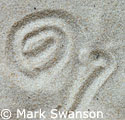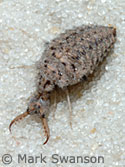Ant Lions have fascinated me for a while now. It started when Clarence, a retired biology teacher introduced me to their fascinating behavior and metamorphoses. When the insect lab came up, I just had to get these creatures for my students.

I found some ant lions on line and paid dearly for them. My mom helped me catch ants to keep them fed until I could pawn them off on the kids! I discovered that ant lions eat crickets and meal worms too. This made my job easier because I have plenty of those in the classroom. Yesterday my husband and I were walking around some property that is for sale near hear. At the back of the property we found a large abandoned chicken house and guess what I found on the dusty floor of the broken down structure? All along the dirt floor we saw pits, large and small with
ANT LIONS!
The ant lion is not an ant and not a lion. Have you ever heard of a "doodlebug"? A doodlebug is actually an ant lion in it's larval or baby stage. You can be sure that I will be back there to get FREE ant lions for next year's lab:) Here are some interesting facts about ant lions:
 We get the name ant lion because they are voracious predators of ants and other insects.
We get the name ant lion because they are voracious predators of ants and other insects. 
Do ant lions make good pets? Ant lions are some of the coolest insects around. When you have an ant lion for a pet, you get a front row seat to one of nature's wildest battles. Ant lions are not only entertaining, but also very educational. You can learn about how insects think, learn, and respond to their environment. Choose an ant lion if you are looking for a pet that is easy to keep and entertaining for the whole family .
Feeding the ant lion is quite easy. Simply drop in to the cage a few ants, a small cricket, meal worm, or any small insect two times a week . I have plenty of crickets in my classroom and students are returning for more, to feed their hungry lions. You can leave the top off the cage when there are no insects for the ant lion to eat. The ant lion can not crawl out.
Why are they called ant lions? The name "ant lion" best describes this insect's predacious larval form—a mottled gray or brown creature with an oversized head, spiny jaws, short legs, and a soft body covered in bristles. Since it preys primarily on ants, the ant lion is, metaphorically speaking, a "lion" among ants. The larvae of some ant lion species hide under bits of debris or wood and attack passing insects. In sandy regions, some species dig a shallow cone-shaped pit and wait at the bottom for an ant or other insect to slip on the loose sand and fall in, only to be immediately devoured . These pit-digging ant lions are called "doodlebugs" in the United States because of the designs they make in the sand. As a doodlebug seeks an ideal location to dig its pit, it leaves meandering trails that resemble the random "doodles" of a preoccupied artist. When it finally finds the right place to dig, the doodlebug "draws" a series of concentric spirals, each deeper than the last, until the pit is excavated. Adult ant lions resemble dragonflies or damselflies The adult is seldom seen in the wild because it is active only in the evening.

For more information you can check these videos:






























































